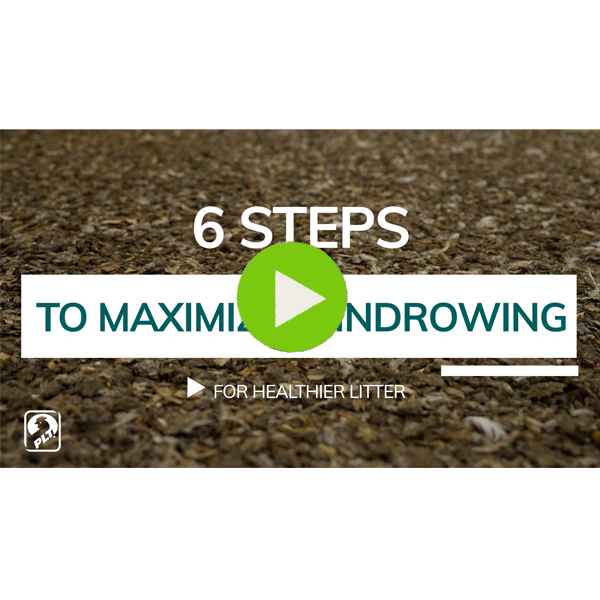6 Tips for More Effective Poultry Litter Windrowing
Managing Litter Ammonia pH and Ammonia After Windrowing
In-house litter composting, or windrowing, is a popular litter management practice to reduce pathogen loads in litter and improve broiler performance. While managing the process effectively can be time consuming, litter windrowing that is done well has been shown to support ideal house conditions.
6 Steps to Maximize the Effectiveness of Windrowing
Step 1: Check Moisture Levels Prior to Starting Poultry Litter Windrowing
Optimal litter moisture content is 30 to 35%. If litter moisture and caking is excessive, consider removing some caked litter before forming windrows.
Step 2: Form Windrows with Poultry Litter
Pile litter into rows down the length of the house. Windrows should be at least 20 inches tall to ensure proper pile mass for good heating. Depending on litter depth, this will require 2 or 3 windrows.
 Step 3: Reach 135oF for a minimum of 72 hours
Step 3: Reach 135oF for a minimum of 72 hours
Monitoring windrow temperature is very important. This is easily done with a simple compost probe thermometer. If you don’t reach the target temp for long enough, pathogen reduction won’t be as effective and your poultry litter windrowing will have been a lot of time and expense for not much result.
Step 4: Turn windrows
After 72 hours at 135°F, turn the windrows to rotate material on the outside of the piles to the inside, and allow the litter to reheat for at least another 72 hours.
Step 5: Spread and ventilate
Spread the litter out evenly across the house and, and using static (negative) pressure, ventilate to remove moisture and ammonia. Keep the houses as warm as possible to keep the litter warm. This will expedite the drying and ammonia removal process. Cold litter will retain moisture and ammonia.
Step 6: Apply PLT @ rate of 150-200 lbs./1,000 sq. ft.
After poultry litter windrowing, it is likely there will be high ammonia concentrations so be sure to apply PLT at a sufficient rate to eliminate ammonia and reduce litter pH. Consult your JH Ag rep to confirm an ideal application rate, especially if excess litter moisture remains.
The technical team at Jones-Hamilton has guided poultry growers through the process of windrowing for years and taught countless classes on the topic to ensure maximum effectiveness. If you want assistance on ensuring your windrowing program is delivering the results you want, contact us today to schedule a consultation.
PLT Rates for Windrowed Houses
Windrowed houses have some of the highest ammonia readings, commonly reaching 200 PPM or higher. Applying a litter amendment at the standard rate following litter windrowing will likely not be enough to handle the higher ammonia challenge, so a higher rate is needed to keep ammonia under control during brooding.
A study was done to determine what application rate is sufficient to control pH and ammonia for an appropriate amount of time. Download the paper here.


 Step 3: Reach 135oF for a minimum of 72 hours
Step 3: Reach 135oF for a minimum of 72 hours